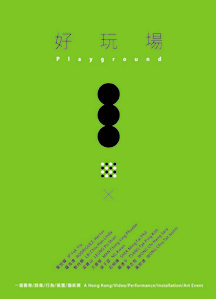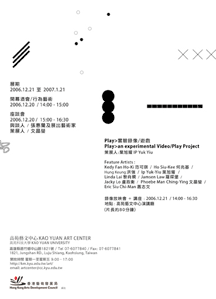(Please scroll down for English)
  |
香港的好玩場
序言
要怎樣形容新一代的香港藝術?「玩」可以是一個可行的形容詞。
所有生物天生也懂得玩,也愛玩,例如剛出生的狗仔,牠們喜歡咬來咬去,完全懂得甚麼是玩甚麼是攻擊,玩的時候不會咬傷對方。愛玩是天性,目的是尋找樂趣,就如香港藝術家的創作對市場的考慮較少,(或許根本沒市場可考慮),心態都比較自然,大多基於內在需要而創作,創作過程中的樂趣便是最佳的回報。較少見一些為爭功名而創作的作品,例如一些媒介喜歡的直接、極端的性和暴力的作品便不多見。說粗話、談性都往往要轉幾個圈,講求深度。亦不多見那種藝術銷情較好,便有人跟風的創作。所以香港藝術沒有主流,大都就?自己不同的取向而發展,創作是為了滿足自我的需求,而多於一種宣示,就算涉及社會或歷史的題材,都會由個人層面出發再指向政治議題。
那內省的傾向有時甚至是與現實隔離的,就正如我們玩的時候,往往會遵守一套在現實中不存在的規則,規則與現實的距離愈大愈好玩。那距離亦是遊戲/藝術吸引人的地方。香港生活壓力相當大,工作加班超時好像是應份的,個人空間相當小,藝術創作往往是藝術家暫時離開現實、重拾個人空間的方法。而經歷過達達、Fluxus洗禮的新一代藝術家,往往對歷史抱懷疑態度,創作手法許多都是自訂規則來開展創作,結果有時是開放的,好像我們玩玩具,都沒有預定結果,過程相當重要。加上近年裝置藝術的發展,加強了觀眾的角色,許多作品也有互動的性質,遊戲的味道就更濃了。
香港藝術少市場現實的考慮,以個人的趣味驅動,自訂遊戲規則這種種特色,與遊戲的精神不謀而合。而香港藝術家去年亦有多個打正旗號以「玩」來作為節目主題,例如葉旭耀策劃的「Play>實驗錄像遊戲計劃」、羅海德策劃的「微波國際媒體藝術節、黎肖嫻的「好一個玩字了得 ─ 出入錄像創作的玩耍民族誌」。有關遊戲、有互動性質的作品就更多,例如梁寶山每一次表演只邀請一位觀眾與她的身軀互動的「單打裝置+表演系列」、吳子昆的錄像互動裝置、石明輝的互動數碼遊戲、黃照達的網上互動作業、黃志恆的「土產座標」走入社區創作和講解藝術、曾德平掛上紙製攝影機和遊客互動的行為藝術、我自己經公眾投票再製成的新校園地圖。
今次展覽「好玩場 - 一個香港/錄像/行為/裝置/藝術展」會邀請以上提過的各個藝術家展出裝置作品或表演行為藝術,還會播映由葉旭耀策劃的「Play>實驗錄像遊戲計劃」。其實香港有「玩」的精神的創作很多,這次展覽只能邀請一些明顯地有這方面興趣的藝術家參加。展覽亦會同時舉辦講座,邀請台灣的學者和藝術家一起交流。回港後,我們亦會舉辦公開講座,談我們在台灣的交流和所見所聞。台灣和香港的文化有類似亦有不同的地方,希望通過交流能加深彼此的認識和理解。
文晶瑩
「好玩場」策展人
PREFACE
How should the new generation of Hong Kong Art be described? The word
'Playful' can be one of the possible adjectives to take.
Animals are naturally born to play, for examples puppies like to bite each other. They know what is just a game and what is a real fight. They would not hurt each other when they play. People like playing and having fun. The attitude of seeking pleasure and having fun is recognized by most of the Hong Kong artists. They do not concern much about market. It is probably due to the lack of a local market for local art. Works they made are driven by internal needs, not because of fame. For example, demand by media for direct, extreme, sex and violent works is high. But not many Hong Kong arts would choose to respond. When talking about sex and say dirty words, most of them would do it in a subtle way.
Artists seldom follow market trend and produce marketable copies of others and works of their own. That is why there is no mainstream when talking about Hong Kong art. Everyone follows his or her own way. To create is to achieve self-fulfillment. Art is seldom a proclamation. Therefore most of the works do not touch directly on the social and historical issues. When using arts as a demonstration, artists are mostly starting from a personal point of view, then to a wider political issue.
The personal and private works sometimes separate from the reality. Just
like play, we will follow some regulations, which do not exist in the
real life. The further the distance the more playful the games are. It
is the separation from the lives that make games attractive. Living in
Hong Kong is stressful. Working overtime seems obligated. The personal
space is pretty small. Making art could allow artists a way to be absent
from the reality temporary and a method to have a personal space. After
the age of Dadaism and Fluxus, most of the artists do not follow the previous
ways of making art and they like to set their own rules. The end product
is open, like ways that we play with toys. There is no preset outcome
and the process becomes very important. Moreover, the recent development
of installation art has emphasized the role of audience. A lot of works
are interactive and most of them are like games.
Hong Kong art is not market oriented. It was driven by personal interest
and artists like to set their own rules. These attitudes fit the spirit
of games. Last year, there were several curators/artists using games as
a theme to curate art activities. For example, Yip Yuk Yiu's PLAY >
An Experimental Video/Game Project, Hector Rodriguez's Microwave International
Media Art Festival 2005: Culture as Play, Linda Lai's Ethnography of Play
in/via/with Video Making- International Video Screenings of Microwave
International Media Art Festival 2005 .
There are a lot of works that are interactive in nature and related to
game. For example, Leung Po Shan's On-on-One Solo Installation + Performance.
She invited one person each time to have interaction with her body. Kwan
Ng's video interactive installation, Phil Shek's digital photo games,
Justin Wong's net games, Sara Wong's Local Orientation, Kith Tsang's photo-taking
performance which involves interactions with tourists, and my new work
on public maps, etc.
The above-mentioned artists are invited to make installation or do their performance in this exhibition 'Playground - a Hong Kong/ Installation/ Video/ Performance Event'. We will also show videos of PLAY > An Experimental Video/Game Project. In fact, works having the quality of play are many but for this exhibition, we regret that we could only include all those who are obviously having interest of this area. We also have a talk to have exchange with the Taiwanese scholars and the audience. After going back to Hong Kong, we would have a public talk to introduce the arts that we saw in Taiwan. The culture of Taiwan and Hong Kong are similar and different. I believe through exchange, we would have deeper thought of each others' art and culture.
MAN Chingying Phoebe
Curator of Playground